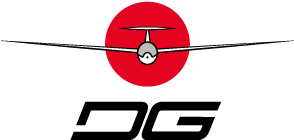By Stefan Göldner 02/2013
Translation: Elke Fuglsang-Petersen
In November 2011, the Indonesian Air Force signed a contract with DG Flugzeugbau to build three new DG-1001Club for their training facilities on the Indonesian Air Force Base. One year later, in November 2012, a container with the new gliders was delivered to Jog-Jakarta. The agreement between DG Flugzeugbau and the Indonesian Air Force included a flight- and maintenance training in Jog-Jakarta, and I was elected to travel to Indonesia. The trip was scheduled for February 2013. As Indonesia is not known as a soaring nation in Europe, I would like to introduce the soaring community to some Indonesian Gliding.
Let’s first go back to the beginning of the story:
The trip had originally been planned for January. The container with the gliders had already arrived on the Air Force Base and everybody was excited to unload the new ships. But Monsoon rainfalls forced us to delay my travel dates. By the beginning of February, the weather looked better, and while in Munich three inches of fresh snow had fallen from an overcast sky, I drove to the airport to fly southeastwards to Indonesia. I had filled my suitcase with summer clothes and left my winter coat, boots, gloves and the scarf on Munich’s International Airport. It seemed unbelievable to me that some hours later I would be leaving the plane facing hot summer temperatures. Well, I’ve never done this before during the German winter time.
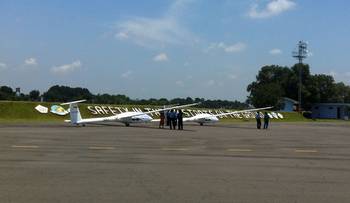 Some 30 hours later, I arrived at Jog-Jakarta’s (“Jogja”) airport. An hour before midnight the thermometer was still showing comfortable 32°C (90°F)! Thinking of the grey winter back home, I felt like dreaming.
Some 30 hours later, I arrived at Jog-Jakarta’s (“Jogja”) airport. An hour before midnight the thermometer was still showing comfortable 32°C (90°F)! Thinking of the grey winter back home, I felt like dreaming.
The following three days then taxed my patience. While all paperwork to enter the Base was supposed to be ready by Monday morning, Bram U. Kusuma, our representative in Indonesia, and I had to wait until Tuesday evening to finally receive all the necessary permissions to be able to enter the facilities.
After such a long wait, we used our long saved energy to unload the gliders right away. Unfortunately I realized that the conditions for such a job were not the best. 40°C (104°F) inside the container and 100 % humidity from the rain that had just stopped transformed our late night job into a real torture. Especially because my body was still adjusted to the European winter conditions. But three hours and consuming five liters of water later, we could finally park the gliders disassembled in the hangar.
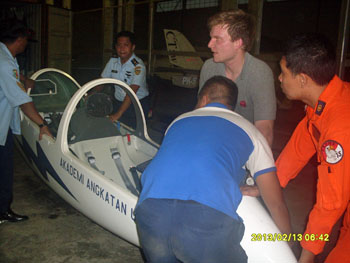 The next day was already Wednesday, and we rigged the new ships. Everybody was excited about the DG-1001Club, the quick rigging and de-rigging process and the gliders’ nice handling!
The next day was already Wednesday, and we rigged the new ships. Everybody was excited about the DG-1001Club, the quick rigging and de-rigging process and the gliders’ nice handling!
Nobody in the Indonesian Air Force had ever seen anything similar before. While three Air Force experts approved the two-seaters for flight, I took advantage of the break and had a look around the airfield.
The Jogja Airport is used by several parties. The terminal for the civilian customers is to the North of the two kilometers long runway. Smaller aircraft and airliners up to Boeing 737-900 are being handled over there. On the southern side there are the Air Force Academy’s facilities. They have squadrons of Cessnas C-172, Beechcrafts T-34 “Mentor” and KT-1. Three American built Schweizer SGS 2-33 which had so far been used for glider training would now be able to retire from services. The ships looked pretty old and they will now, after thousands of launches, be replaced by the DG-1001Club.
A huge casern-building and a golf course with sand-pits shaped like aircraft are also part of the airfield’s military facilities. The grass strip used for glider training is only 80 meters (250 feet) south of the main runway. It started to rain, and some generals came out to visit the Air Force Base, so no more flying on Wednesday.
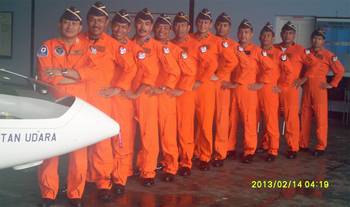 The next day, we were finally able to do the check flights which had been requested by the Air Force.
The next day, we were finally able to do the check flights which had been requested by the Air Force.
While being watched by the staff, it was my job to fly all three gliders and demonstrate some aerobatics which are part of the Air Force’s requirements.
During the tows I enjoyed the views of the unfamiliar tropical landscape. Those thousands of small buildings spread around innumerable paddy fields drew my emotions. I felt like being in a movie.
To the North, the “Letusan Merapi” overlooked the scenery. To the East there are the “Ngoro Oro”-mountains. The Bavarian Forest with its “Großer Arber” came to my mind. Everything is tinted in dark tropical green colors. Because of the paddy fields there are probably no outlanding possibilities.
Regardless of the Air Force’s regulations, I tried to thermal under a cloud. Unfortunately I couldn’t center it properly – after the first two circles the ground called me on the radio. I think it might have been 3-4 meters (6-8 knots) under a cloud base of 3,500 feet. Not bad! Like every day, between 3 and 4pm it started to pour and no more glider flights were possible on this afternoon.
For those wondering why we only did three launches on one day, I have to explain about the procedures. Everything is slower than our European operations in clubs. Flights are planned during different “pre-” and “de-briefings” while things happen which were not planned at all.
Originally we had considered three flights, and because of the Air Force’s long chain for decisions which extended our operations the day ended with just these three launches. Appointments suffer from the same aspects. One or two hours late have to be considered.
On Friday I could finally check out four of the Indonesian Air Force instructors. Like the other day we were being towed by a C-172 Rocket. The pilots had no problems to get used to the new two-seaters, and we managed to do ten of the planned twelve launches. A huge thunderstorm then approached and we had to cancel the operations for the day.
Everybody was happy with the new high performance sailplanes. Many of them couldn’t believe about the new opportunities offered by the ships. They really enjoyed the aerobatic performance which before could only be experienced in turboprop trainers like the KT-1.
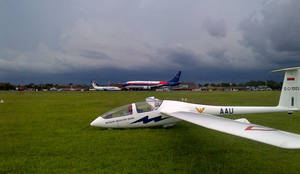 Flying next to the airliners seemed unfamiliar to me. During one of the check flights I had to land parallel to a Lion Air 737-900, which was only 250 feet next to my cockpit! In Indonesia, this is completely normal and not a problem. A German controller’s hair would stand on end. But things work different here.
Flying next to the airliners seemed unfamiliar to me. During one of the check flights I had to land parallel to a Lion Air 737-900, which was only 250 feet next to my cockpit! In Indonesia, this is completely normal and not a problem. A German controller’s hair would stand on end. But things work different here.
After this week, I had to leave for cold Germany on a Sunday. The temperatures in Indonesia were much more enjoyable!
On the whole, the trip was a very interesting and manifold experience. Many people might know Indonesia as a touristy place, but having the chance to go gliding there was maybe even better.
I would like to especially thank our representative Bram U. Kusuma. He had everything arranged in the background and particularly the first days with the authority’s issues were hard for him:
“Terima kasih!” (Thank you very much!)
